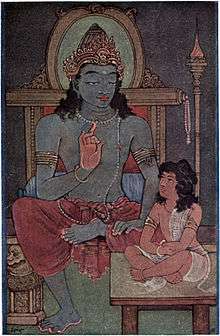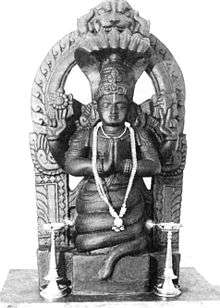Kriyā
Kriyā (in Sanskrit "action, deed, effort") most commonly refers to a "completed action", technique or practice within a yoga discipline meant to achieve a specific result. Another meaning of Kriya is an outward physical manifestation of awakened kundalini, such as a spontaneous body movement related to Kundalini energy flow.
Etymology
Kriyā is a Sanskrit term, derived from the Sanskrit root, kri, meaning "to do". Kriyā means "action, deed, effort". The word karma is also derived from the Sanskrit root √kṛ (kri) कृ, meaning "to do, make, perform, accomplish, cause, effect, prepare, undertake".[1][2] Karma is related to verbal proto-Indo-European root *kwer- "to make, form".[3]
The root kṛ (kri) is very common in ancient Sanskrit literature, and it is relied upon to explain ideas in Rigveda, other Vedas, Upanishads, Puranas, the Epics of Hinduism.[1][4] The root "kri" also appears in the word Sanskrit, to imply a language that is "well made".
Origins
Bhagavad Gita

The Bhagavad Gita does not teach kriya yoga by name. Yogananda and his teachers have claimed that the practice itself is described in the Bhagavad Gita.[5] According to Paramahansa Yogananda in his book God Talks with Arjuna: The Bhagavad Gita, Krishna describes kriya yoga as:
Offering inhaling breath into the outgoing breath, and offering the outgoing breath into the inhaling breath, the yogi neutralizes both these breaths; he thus releases the life force from the heart and brings it under his control.[6]
The Bihar School, which also teaches similar techniques of kriya yoga, claims that the descriptions of kriya yoga in the Yoga Sūtras and the Bhagavad Gīta are not related. [7]
Yoga Sutras of Patanjali
The Yoga Sutras of Patanjali are generally viewed as a compendium of multiple traditions of yoga.[8][9][10] According to Feuerstein, the Yoga Sutras are a condensation of two different traditions, namely "eight limb yoga" (ashtanga yoga) and action yoga (Kriyā yoga),[8] the description of the eight limbs being an interpolation into the text on kriya.[11] According to George Feuerstein, kriya yoga is contained in chapter 1, chapter 2 verse 1-27, chapter 3 except verse 54, and chapter 4.[8] The "eight limb yoga" is described in chapter 2 verse 28-55, and chapter 3 verse 3 and 54.[8]
According to Miller, Kriya yoga is the "active performance of yoga".[12] It is composed of part of the niyamas, "observances", the second limb of Patanjali's eight limbs.[12] According to Miller, Kriya yoga is a threefold discipline, involving ascetic practice, the study and chanting of sacred hymns and syllables, and dedication to god.[12]
Miller also notes that some commentators regard the first five limbs together as kriya yoga, but that Patanjali himself states kriya yoga to be a subset of the second limb.[13]
It is notable, that the kriya yogi is therefor not bound by the other yamas and niyamas and hence is not bound by the rules of cleanliness, non-violence, truthfulness, chastity and various other seemingly monastic practices. This makes the kriya yogi potentially similar to a transgressive tantrika or other non-brahmanical yogis like the vratyas who do not follow vedic injunctions on bathing, marriage, etc.
Contemporary usage
Mahavatar Babaji
The story of Lahiri Mahasaya receiving initiation into Kriya Yoga by the yogi Mahavatar Babaji in 1861 is recounted in Autobiography of a Yogi.[14] Yogananda wrote that at that meeting, Mahavatar Babaji told Lahiri Mahasaya, "The Kriya Yoga that I am giving to the world through you in this nineteenth century, is a revival of the same science that Krishna gave millenniums ago to Arjuna; and was later known to Patanjali, and to Christ, St. John, St. Paul, and other disciples".[15] Yogananda also wrote that Babaji and Christ were in continual communion and together, "have planned the spiritual technique of salvation for this age."[16][17]
Swami Sri Yukteswar Giri first told Yogananda, confirmed later directly by Mahavatar Babaji, that he had been chosen to bring Kriya Yoga to the West.[18]. Yogananda then brought Kriya Yoga to the United States and Europe beginning in 1920 and continues to this day through his organization Self-Realization Fellowship. In India the fellowship is called Yogoda Satsanga Society of India.[19]
According to Yogananda,:
Kriya Yoga is a simple, psychological method by which human blood is decarbonated and recharged with oxygen. The atoms of this extra oxygen are transmuted into life current to rejuvenate the brain and spinal centers. By stopping the accumulation of venous blood, the yogi is able to lessen or prevent the decay of tissues. The advanced yogi transmutes his cells into energy.[15]
Sudarshan Kriya
Sudarshan Kriya is a set of breathing techniques promoted since 1982 by Sri Sri Ravi Shankar.[20]
Sudharshan Kriya employs a variety of breathing patterns.[21][22]
Baba Haidakhan
Publications on Babaji describe Kriya Yoga as practiced by Baba Haidakhan who died in 1984.[23][24] Haidakhan Babaji, simply called "Babaji" or Bhole Baba by his students and devotees, was a teacher who appeared in northern India (Uttarakhand) and taught publicly from 1970 to 1984.
Some modern teachers and institutions consider the entire Yoga Sutras to be Kriya Yoga, although Patanjali only relates the term Kriya Yoga to these three foundation practices (tapas, swadhyaya, Ishwara pranidhana). Breathing practices with attention along the spine are often included, along with other physical practices. It is useful for the student of yoga to be aware of these different approaches, so as to not get confused by the various public offerings.[25]
See also
References
- 1 2 see:
- kṛ, कृ Monier Monier-Williams, Monier Williams Sanskrit-English Dictionary (2008 revision), pp 300-301;
- Carl Cappeller (1999), Monier-Williams: A Sanskrit-English Dictionary, Etymological and Philologically Arranged with Special Reference to Cognate Indo-European Languages, Asian Educational Services, ISBN 978-8120603691
- ↑ Mulla & Krishnan (2009), Do Karma-Yogis Make Better Leaders? Exploring the Relationship between the Leader's Karma-Yoga and Transformational Leadership, Journal of Human Values, 15(2), pp 167-183
- ↑ John Algeo and Thomas Pyles (2010), The Origins and Development of the English Language, 6th Edition, ISBN 978-1428231450, pp 54-55
- ↑ See Rigveda 9.69.5, 10.159.4, 10.95.2, Svetâsvatara Upanishad 2.7.v.1, Mahabharata 1.5141, etc.
- ↑ Paramahansa Yogananda, Autobiography of a Yogi
- ↑ Paramahansa Yogananda (1995). God Talks with Arjuna: The Bhagavad Gita (Verse IV:29), First Edition. Self-Realization Fellowship. ISBN 0-87612-030-3.
- ↑ Swami Satyananda, Asana, Pranayama, Mudra, Bandha
- 1 2 3 4 Feuerstein 1978, p. 108.
- ↑ Tola, Dragonetti & Prithipaul 1987, p. x.
- ↑ Wuyastik 2011, p. 33.
- ↑ Stiles 2011.
- 1 2 3 Miller 2009, p. 44.
- ↑ Miller 2009, p. 45.
- ↑ Autobiography of a Yogi, chapter 34, Materializing a Palace in the Himalayas, by Paramahansa Yogananda
- 1 2 Yogananda, Paramahansa (1997). Autobiography of a Yogi. Self-Realization Fellowship. p. 273, The Science of Kriya Yoga. ISBN 0876120869.
- ↑ Miller, Timothy (1995). America's Alternative Religions. SUNY Press. p. 178. ISBN 0791423972.
- ↑ Autobiography of a Yogi, chapter 33, pg.307, by Paramahansa Yogananda
- ↑ Autobiography of a Yogi, ch. 37.
- ↑ Autobiography of a Yogi, ch. 26.
- ↑ http://articles.timesofindia.indiatimes.com/2003-09-09/bangalore/27189063_1_sudarshan-kriya-sudarshan-kriya-spinal-cord
- ↑ Zope, SameerA; Zope, RakeshA. "Sudarshan kriya yoga: Breathing for health". International Journal of Yoga. 6 (1): 4. doi:10.4103/0973-6131.105935.
- ↑ http://www.health.harvard.edu/newsletters/Harvard_Mental_Health_Letter/2009/April/Yoga-for-anxiety-and-depression
- ↑ Devi, Gaura (2001). Fire of Transformation. My life with Babaji. Devon, UK: Nymet Press. ISBN 0-9541839-0-8.
- ↑ Mishra, Giridhari Lal (2011). From Age to Age: Stories of Haidakhan Babaji. American Haidakhan Samaj. ISBN 978-0578085463.
- ↑ http://www.swamij.com/yoga-sutras-20109.htm
Sources
- Feuerstein, George (1978), Handboek voor Yoga (Dutch translation; English title "Textbook of Yoga", Ankh-Hermes
- Miller, Barbara (2009), Yoga: Discipline of Freedom: The Yoga Sutra Attributed to Patanjali, Random House LLC
- Stiler, Mukunda (2011), Tantra Yoga Secrets: Eighteen Transformational Lessons to Serenity, Radiance, and Bliss, Weiser Books
- Tola, Fernando; Dragonetti, Carmen; Prithipaul, K. Dad (1987), The Yogasūtras of Patañjali on concentration of mind, Motilal Banarsidass
- Wuyastik, Dominik (2011), The Path to Liberation through Yogic Mindfulness in Early Ayurveda. In: David Gordon White (ed.), "Yoga in practice", Princeton University Press
